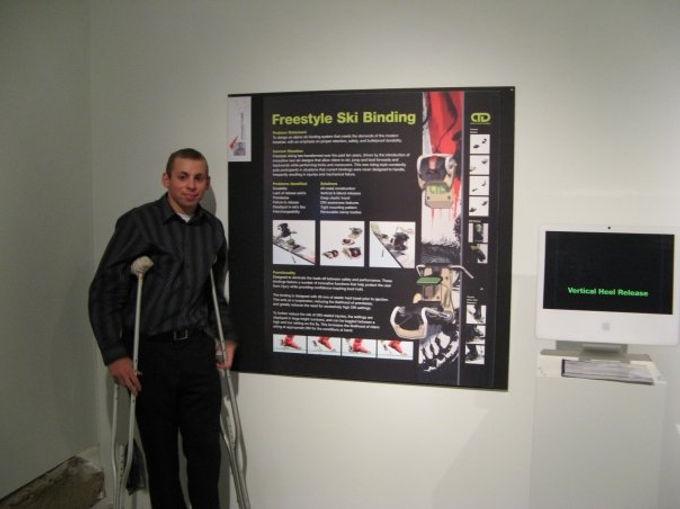



Above is the final presentation deck from my senior industrial design thesis at the Ohio State University. This presentation was completed in 2009, and was completed over an eleven week period.

During this time I was on crutches recovering from a second knee surgery and had just built my first real workstation computer. That combination of real compute power, limited distractions, and the frustrations of my own experiences led me straight towards this project.

This binding design utilized 3D tube bending to create a sort of guide track that the toe and heel elements rode on. A key insight I locked in on was extending event impact time so that boot pre release could be more precisely controlled. To achieve this, the heel track guided the heel on a virtual motion path where boot ejection only occurred after a long elastic travel section was completed. Two stacked spring packs controlled the vertical and lateral heel ejection mechanisms.
The toe piece and it's wings and spring pack all rode within a similar bent tubular frame. Another feature these had was a switch that could bump up the DIN slightly on demand. I imagined these spring packs might be air springs for lightweight, and they could contain hydraulic damping circuits to further tune the binding "feel".
These bindings were designed in such a way that all mounting screws to the ski occurred underfoot. This is an ideal situation for retaining ski flex characteristics. I also have is so that the toe and heel could be potentially swapped between skis by just adding another set of baseplates. The brake design on the binding is width adjustable to facilitate switching between different sized skis.
A few things I must note, publishing this now and looking back with hindsight, is that none of the background images used as background imagery are credited, most of them are not my own, just images I liked and described the page. All of the sketches, renders and CAD models are however my own.
Also, It is clear that there are some technical challenges present in this design, as well as many aspects that are fully unresolved! The resetting of the binding was very roughly and solved by including a pull tab that released the binding via cables that would compress and release the hold down spring so you could step out. This is a poor solution; you couldn't just step out. The tolerances and stiffness required by the bent tube structures is a major issue, and the friction and wear on parts guiding the motion system are problematic.
That said, In 2025 as I write this I still think a lot of the design holds up, and I think the motion path based ejection strategy could be further explored. While this project never moved beyond what was shown here, It set the stage for my future ventures and after it, I set the goal to be meaningfully closer to solving the knee issue in skiing by the time I was thirty.
By the time 30 rolled around myself and Giray Dadali had started Daymaker Touring where our adapters allow backcountry skiers to keep their releasable bindings and transfer between many different skis, and as I round out my thirties I now have launched Project Fawn where I am building 3D printed ski boots that, among other things, might be able to solve the problems outlined here by using forces and body position from the boot to operate not-yet created, boot-based release modalities that can "sense" a compromised body position. operation

